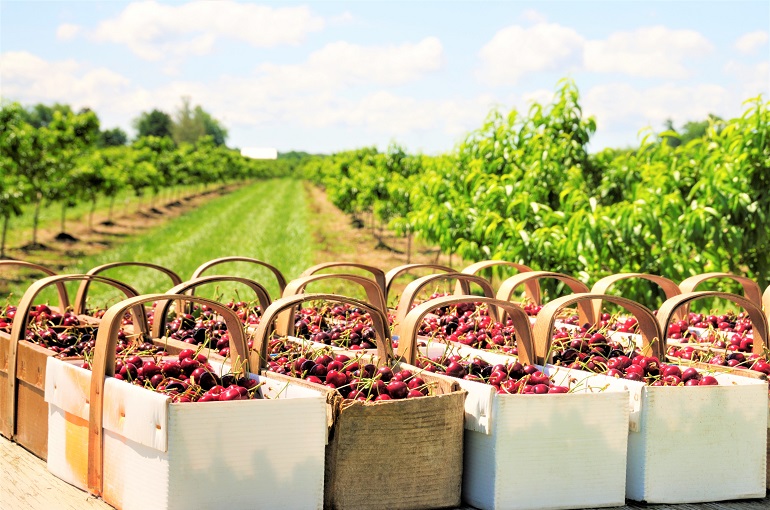Cherries Harvesting and Yield per Hectare – Do you pick cherries with the stem on or off?

This post is also available in:
This post is also available in:
![]() Español (Spanish)
Español (Spanish) ![]() Français (French)
Français (French) ![]() Deutsch (German)
Deutsch (German) ![]() Nederlands (Dutch)
Nederlands (Dutch) ![]() हिन्दी (Hindi)
हिन्दी (Hindi) ![]() العربية (Arabic)
العربية (Arabic) ![]() Türkçe (Turkish)
Türkçe (Turkish) ![]() 简体中文 (Chinese (Simplified))
简体中文 (Chinese (Simplified)) ![]() Ελληνικά (Greek)
Ελληνικά (Greek) ![]() Português (Portuguese (Brazil))
Português (Portuguese (Brazil))
Cherries Yield per Hectare
As in other fruit trees, the yield of cherries highly depends on the variety, the age of the tree, the training system (tree architecture), the environmental conditions, and the cultivation practices (e.g., irrigation, fertilization, etc.). Generally, sour or tart cherries can produce up to 9.5 tons per hectare (3.84 tons per acre). More specifically, a sour dwarf cherry tree may produce 11.4-19 kg, while a semi-dwarf sour tree can give up to 45.4-68 kg (or 23.1-42 and 100-150 pounds, respectively). On the other hand, sweet cherries in full production capacity can give on average 4-10 tons per hectare (3272 to 8000 lbs. per acre), while some very high yields more than 14 tons per hectare (12,490 pounds or 5.67 tons per acre) have been recorded in super-intensive cherry orchards that are managed by very experienced growers. Cherry orchards with yields of more than 20 tons per hectare typically produce cherries of low quality, taste and sugar content.
When and how to harvest cherries?
Which are the most important quality characteristics of cherries?
Depending on the grafted variety and the rootstock, cherry trees start producing fruits in the 3rd-5th growing year. Cherries are “summer fruits” since they are ready to be harvested during that period. The way a farmer will choose to harvest highly depends on the architecture (training) of the trees, the type-species of cherries (sweet or sour), the production purpose (fresh consumption or processing), and the availability of machinery or staffing. A cherry tree can be harvested six or seven times during the same season.
Some farmer measure the sugar content of cherries with a refractometer in order to spot the ideal time of harvest. We should focus on harvesting when the fruits are fully ripe and the skin has obtained the characteristic color of the variety. Generally, the soluble solids content (SSC) is important maturity indice, and the ripe fruits should have a minimum of 14-16% SSC to be harvested. The longer the fruits remain on the trees, the higher the sugar accumulation and flavor (especially for sweet cherries, a tool than can be used is the digital refractometer (% Brix)). However, there is an increased risk of quality deterioration and yield loss (diseases-birds, the softness of the fruit, etc.).
Visual appearance is very important for consumers, and the fruits should be:
- fully colored with glossy, firm skin
- large in size (24, 26, 28 mm in diameter), juicy and crunchy
- free of cracks and bird pecks
- firm and not shriveled or decayed
- attached to fresh green stem
It is crucial to start harvesting when the weather is dry and during the cooler hours of the day. Handpicking is possible and sometimes recommended, but it needs an experienced crew in order not to injure the fruits themselves but also the spur (fruiting twig). The spur is required for future years’ production. To reduce the risk of post harvest infections, it is essential to collect (with scissors) the cherries with the stem attached. The harvesting is usually done mechanically for cherries that will be directed to the process industry or/and in large commercial cherry orchards. Growers control a harvester machine with a joystick. The mechanical harvester has a large arm that “hugs” the trunk and shakes it to cause the fruits to fall into the collecting nets. Then, they drop into a roller belt leading to a fan. The fan will help to separate the leaves from the fruit stalk. After the necessary first stage sorting (broken stems and leaves are removed), the individual fruits usually drop in a box. Therefore, they are ready to be stored.
Post-harvest management of cherries and storage
Right after harvest, it is vital to take action and reduce both the temperature and the transpiration (moisture/weight loss, fruit shrivel). For this purpose, the freshly harvested fruits should be kept in a shaded place while remaining on the farm and transported to a storage-cooling area with controlled environmental conditions. More specifically, for longer storage of cherries, the temperature should be kept between -0.5 and 0.5 °C , the relative humidity at 90-95% (to preserve the green color of the stems), 3 to 10% O2 and 10 to 15% CO2. Ethylene is generally not added. Except for the environmental conditions, the producer must take all preventive measures to ensure good sanitation and avoid any post-harvest contamination from pathogens or pests. The storage life of cherries also depends on the health of the fruits stored and the variety’s characteristics. For example, varieties like ‘Summit,’ ‘Newstar,’ ‘Van,’ and ‘Sonata’ are susceptible to pitting and unsuitable for long-term storage (max 15 days). On the other hand, ‘Santina,’ ‘Bing,’ ‘Rainier,’ and ‘Sweetheart’ can be stored successfully for up to 45 days.
References
- https://u.osu.edu/cfaescapstone/tree-fruits/cherries/care-maintenance/
- https://anrcatalog.ucanr.edu/pdf/2951e.pdf
- https://postharvest.ucdavis.edu/Commodity_Resources/Fact_Sheets/Datastores/Fruit_English/?uid=17&ds=798
- https://www.cherrygrowers.org.au/assets/
- https://www.cherrygrowers.org.au/assets/181114_Cherry_QA_Booklet_to_accompany_poster.pdf
- https://www.cherrygrowers.org.au/assets/181114_Cherry_QA_Booklet_to_accompany_poster.pdf
- https://www.nasda.org/wp-content/uploads/2022/09/2021-June-Cherry-Production-Enumerator-Training.pdf
- https://agsci.oregonstate.edu/sites/agscid7/files/oaeb/pdf/AEB0032.pdf
- http://www.calu.bangor.ac.uk/Technical%20leaflets/020404%20CALU%20cherries.pdf
- https://www.freshplaza.com/europe/article/2196846/twelve-years-and-14-tons-of-production-per-hectare/
Cherries: Info, Facts, Nutritional Value & Health Benefits
Plant Information of cherries
10 Interesting Things About Cherries You Probably Didn’t Know
Growing Cherry Trees for Profit
Soil requirements, preparation, and planting of cherry trees
Cherry Tree Water Requirements
Cherry Tree Propagation and Pollination
Cherry Tree Training, Pruning, and Fruit Thinning
Cherry Tree Fertilization
Cherry Tree Pests and Diseases
Cherries Harvesting and Yield per Hectare – Do you pick cherries with the stem on or off?









































































